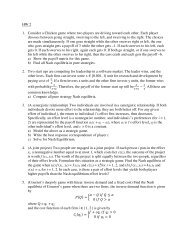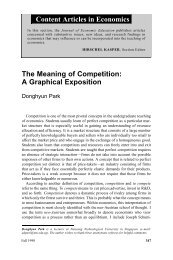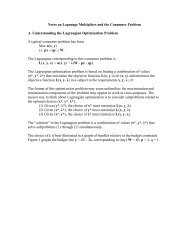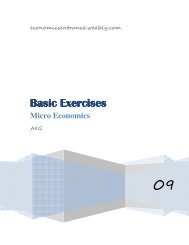A Diagrammatic Proof That Indirect Utility Functions Are Quasi ...
A Diagrammatic Proof That Indirect Utility Functions Are Quasi ...
A Diagrammatic Proof That Indirect Utility Functions Are Quasi ...
Create successful ePaper yourself
Turn your PDF publications into a flip-book with our unique Google optimized e-Paper software.
A <strong>Diagrammatic</strong> <strong>Proof</strong> <strong>That</strong> <strong>Indirect</strong> <strong>Utility</strong> <strong>Functions</strong> <strong>Are</strong> <strong>Quasi</strong>-Convex<br />
Author(s): Wing Suen<br />
Source: The Journal of Economic Education, Vol. 23, No. 1 (Winter, 1992), pp. 53-55<br />
Published by: Heldref Publications<br />
Stable URL: http://www.jstor.org/stable/1183478<br />
Accessed: 13/04/2009 10:45<br />
Your use of the JSTOR archive indicates your acceptance of JSTOR's Terms and Conditions of Use, available at<br />
http://www.jstor.org/page/info/about/policies/terms.jsp. JSTOR's Terms and Conditions of Use provides, in part, that unless<br />
you have obtained prior permission, you may not download an entire issue of a journal or multiple copies of articles, and you<br />
may use content in the JSTOR archive only for your personal, non-commercial use.<br />
Please contact the publisher regarding any further use of this work. Publisher contact information may be obtained at<br />
http://www.jstor.org/action/showPublisher?publisherCode=held.<br />
Each copy of any part of a JSTOR transmission must contain the same copyright notice that appears on the screen or printed<br />
page of such transmission.<br />
JSTOR is a not-for-profit organization founded in 1995 to build trusted digital archives for scholarship. We work with the<br />
scholarly community to preserve their work and the materials they rely upon, and to build a common research platform that<br />
promotes the discovery and use of these resources. For more information about JSTOR, please contact support@jstor.org.<br />
http://www.jstor.org<br />
Heldref Publications is collaborating with JSTOR to digitize, preserve and extend access to The Journal of<br />
Economic Education.
A <strong>Diagrammatic</strong> <strong>Proof</strong> <strong>That</strong> <strong>Indirect</strong><br />
<strong>Utility</strong> <strong>Functions</strong> <strong>Are</strong> <strong>Quasi</strong>-Convex<br />
Wing Suen<br />
Duality theory has become part of the standard training of economics<br />
graduate students and many upper-level undergraduates. My teaching experience<br />
suggests that students have little problem understanding why the<br />
cost function is concave or why the indirect profit function is convex,<br />
because a simple envelope-type diagrammatic argument is readily available<br />
(e.g., Kreps 1990; Silberberg 1990; Varian 1984). Many students, however,<br />
have difficulty grasping the quasi-convexity of the indirect utility function.<br />
Although an algebraic proof can be found in textbooks such as Kreps (1990)<br />
and Varian (1984), those who are uninitiated in mathematical language may<br />
find the proof unilluminating if not unintelligble. I have constructed a diagrammatic<br />
proof for use in class, and students seem to be quite receptive.<br />
As a bonus, the proof leads to Roy's identity. The student should be reminded,<br />
however, that the diagrammatic proof is meant to supplementnot<br />
to replace-the algebraic treatment.<br />
The indirect utility function, v(p,,p2,y), gives the maximum achievable<br />
utility when prices are p,,p2 (in the two-good case) and when money income<br />
is y. A convenient way to represent an indirect utility function is the priceindifference<br />
diagram. A price-indifference curve shows combinations of p,<br />
and p2 such that the consumer is indifferent. It is downward sloping because,<br />
when p, is increased, the consumer can maintain the same utility level<br />
only if p2 is reduced. Unlike ordinary indifference curves, however,<br />
the direction of preference points to the southwest: lower prices are preferred<br />
to higher prices. This is a reflection of the fact that indirect utility is a decreasing<br />
function in prices.<br />
A function v(p,,p2,y) is quasi-convex in (p,,p2) if and only if its lower<br />
contour set-the set of prices (p,,p2) such htat v(p,,p2,y) 5 k-is convex for<br />
any k. Because combinations of prices to the northeast of a priceindifference<br />
curve yield lower utility than those on the curve, they constitute<br />
a lower contour set for the indirect utility function. To prove that the indirect<br />
utility function is quasi-convex, it is thus necessary and sufficient to<br />
show that the price-indifference curves are convex to the origin. (When a<br />
utility function is quasi-concave, the associated indifference curves are also<br />
convex to the origin. The apparent inconsistency in terminology is resolved<br />
if one notices that ordinary indifference diagrams and price-indifference<br />
diagrams have opposite preference directions.)<br />
Wing Suen is a lecturer in the Department of Economics, University of Hong Kong.<br />
Winter 1992 53
In Figure 1, the line VV' shows a price-indifference curve. Any point in<br />
the shaded region is preferred to any point on line VV'. As drawn in Figure<br />
1, the price-indifference curve is convex to the origin. To see why this must<br />
be the case, consider an arbitrary point E = (pO,pO). Let (4,x') be the optimal<br />
consumption bundle associated with that set of prices and income.<br />
Draw a line AA ' passing through E with slope -'/x. Any combination of<br />
prices on line AA ' has the property that the bundle (x?,x2) is affordable with<br />
the initial budget. (More precisely, the equation for line AA ' is pl + p2X<br />
= plx + p22. The slope of the line is therefore dp2/dp, = - x/x, as<br />
stated.) Thus, if indirect utility at E is vo, the level of utility at any point on<br />
AA ' must be at least vo. When prices change from point E to some other<br />
point on AA ', the consumer can maintain the same utility level by keeping<br />
his consumption bundle unchanged. Usually he can do better by substituting<br />
away from the good that is now more expensive. It follows that the<br />
price-indifference curve for utility level vo must lie within area AEC to the<br />
left of E and within A 'EC' to the right of E. VV' is therefore bounded below<br />
by AA ' and is tangent to AA ' at E. (The tangency condition obtains<br />
when the consumer maximizes utility at a regular interior solution. The student<br />
may be invited to guess what the price-indifference curve would look<br />
like when x, and x2 are perfect substitutes or perfect complements.) This in<br />
turn implies that the price indifference curve is convex in the neighborhood<br />
of E. Because the point E is arbitrary, the same argument can be used to<br />
show that price-indifference curves are everywhere convex to the origin. In<br />
other words, the indirect utility function is quasi-convex.<br />
P2<br />
A<br />
????I??V<br />
... .. ..<br />
.. .. .........~?~. ..<br />
..<br />
.......... ..<br />
...<br />
... ... ..<br />
..... ....<br />
. .. . .<br />
...........<br />
.... ... ...<br />
..<br />
.<br />
0<br />
0<br />
... ..<br />
...........<br />
..<br />
... ... . . ..<br />
??? ??????E<br />
. .<br />
? ? ? ? ? P2?? ??<br />
.<br />
.<br />
..<br />
FIGURE I<br />
A Convex Price-Indifference Curve<br />
. . . . . . . . . .<br />
. . * .<br />
......... ........<br />
. . . . . . .<br />
........ ..... .... ... .... ........ .... .... ...<br />
..................? . . . . . . . ....<br />
.. .. . . .. . . .. . . . . .. . . . . .<br />
I.. . .................. . I.. . . . I . .... . . . ....... . . . . , , . . .... . ????<br />
??V .<br />
.................... .................. .. .. . .. . .. .. .... ..I . .... . .<br />
.................... ... ....<br />
..... ..<br />
. ... . ... .. .. ... .. .. .. . .. .. .. .. .. ... .. ... .. .. .. . .. ... ..<br />
. ................ ......~?<br />
????A ????? ?? ?? 0 ??<br />
A ? ?<br />
, , I . . . . . . I .<br />
54 JOURNAL OF ECONOMIC EDUCATION<br />
A
Our argument also establishes that, for the regular case, the priceindifference<br />
curve has the same slope as AA' at point E. Thus,<br />
- (6v/6p,)/(6v/6p2) = - x'/xl. As an exercise, the student can be asked to<br />
show that this tangency condition is just a restatement of Roy's identity.<br />
(Hint: Apply Euler's theorem to the indirect utility function. Then plug in<br />
the tangency condition and use the budget constraint.)<br />
REFERENCES<br />
Kreps, D. 1990. A course in microeconomic theory. Princeton: Princeton University Press.<br />
Silberberg, E. 1990. The structure of economics: A mathematical analysis. 2nd ed. New York:<br />
McGraw-Hill.<br />
Varian, H. 1984. Microeconomic analysis. 2d ed. New York: Norton.<br />
STUDENTS SOLVE<br />
ECONOMIC<br />
MYSTERIES with CAPSTONE<br />
The Nation's High School Economics Course<br />
The CAPSTONE course lets your students solve many<br />
economic mysteries. By looking at the choices people make<br />
and just what influences those choices, students learn that<br />
economic analysis can make sense out of puzzling behavior.<br />
The program focuses sharply on reasoning by posing certain<br />
issues or events as mysteries. For example: Why are young<br />
people, the future of our country, the group with the highest<br />
level of unemployment? Students unravel this mystery by<br />
acting as detectives, seeking and observing economic clues,<br />
then drawing logical conclusions.<br />
Mail coupon to: JOINT COUNCIL ON ECONOMIC EDUCATION / MARKETING DEPT.<br />
432 PARK AVENUE SOUTH, NEW YORK, NY 10016<br />
O Please send the complete CAPSTONE teaching package: Teacher Resource Manual and<br />
Student Activities Book plus a bonus set of resource materials-all in a convenient storage<br />
box. I understand the Joint Council will bill me for $119.95, plus shipping and handling.<br />
Name Position<br />
School<br />
Street Address<br />
(must be included)<br />
City, State, Zip<br />
Purchase Order No.: Date:<br />
School Telephone No.:<br />
D Send more information on CAPSTONE. JEE92<br />
Winter 1992 55




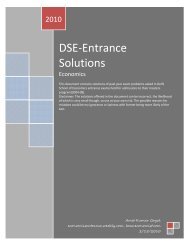
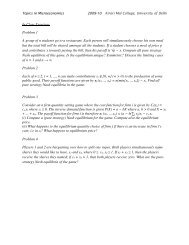


![2. Each of n ≥ 2, i = 1, ..., n can make contributions s i ∈ [0, w] (w ...](https://img.yumpu.com/19311695/1/190x245/2-each-of-n-2-i-1-n-can-make-contributions-s-i-0-w-w-.jpg?quality=85)
